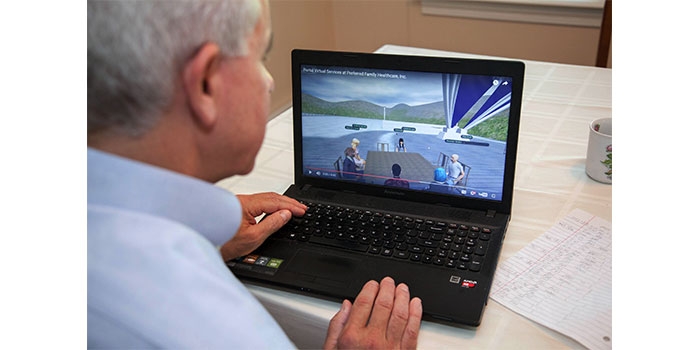Technology Takes Therapy out of the Office and onto Electronic Platform
- News & Events
- News
- Technology Takes Therapy out of the Office and onto Electronic Platform

“Not everyone is comfortable with this reality, but technology is here. You can’t un-ring the bell,” says Professor of Social Work Frederic Reamer
Traditionally, service delivery between a professional counselor and his or her client was a person-to-person live interaction in the counselor’s office.
We live in a world now where most of the population communicates via email, text messaging, smartphone apps, videos, Facebook and Zoom. Thus, counseling practices have evolved to treat clients using these technologies. The new catchword in therapeutic circles is electronic counseling or e-counseling.
“Not everyone is comfortable with this reality, but technology is here. You can’t un-ring the bell,” said RIC Professor of Social Work Frederic Reamer. “As faculty, our job is to educate future clinical social workers about the kind of technology they will be encountering in the field.”
A simple Internet search for “online counseling” produces pages of websites offering services for as low as $25 an hour. Appointments are booked online, conducted online and paid for by PayPal or credit card. Moreover, clients can remain completely anonymous.
Reamer also cited avatar therapy, a form of e-counseling that mimics computer gaming. Both client and provider create an avatar (an animated image) of themselves, place their virtual images in a three-dimensional, virtual-reality environment and interact either in one-on-one or group therapy sessions by typing in their responses.
“This can be helpful for a client who is resistant to treatment and is too traumatized to come in for counseling,” said Reamer. “For example, there are veterans who have major social anxiety and won’t leave their homes or who live too far away from a VA medical center. Avatar therapy allows them to receive therapy that they might not otherwise receive.”
How effective is e-counseling? Researchers say that the online therapeutic relationship is as effective as the live therapeutic relationship in producing positive outcomes (“Journal of Technology in Human Services,” 2008). As human beings become more attuned to and more dependent on technology in their everyday lives, human problems can be effectively addressed through electronic means.
What’s more, mobile apps are being used to supplement face-to-face therapy. Tech-savvy teenagers who prefer text messaging, can text their counselor when they are in crisis rather than wait for an in-office appointment.
High-risk teens who have difficulty self-regulating (calming down when angry or anxious) can download an app to their smartphone and follow cues from the app to help them self-manage their emotions, thoughts and behaviors.
Suicide interventions are also being conducted online. A new partnership between Facebook and the National Suicide Prevention Lifeline enables Facebook users to report a suicidal comment posted on Facebook. The person who posted the comment immediately receives an email from Facebook encouraging them to call the National Suicide Prevention Lifeline or to click on a link to begin a confidential chat session with a crisis worker.
“These are the major technologies and they’re transforming the way social work faculty think about educating their students. Students should know about them, whether or not they use them, because more and more of their clients are going to ask about them,” Reamer said.

Online professional networks are also a rich source of information. Clinical social workers can now go online, join a network of other clinicians who specialize in different areas and work as a team on a case.
“In the past, you just walked down the hall and knocked on a faculty member’s door for advice or you found a local expert. Online networks allow you to connect with professionals from all over the world,” Reamer said.
Yet for all its benefits, the integration of technology into counseling practice does not come without its trade-offs.
Reamer’s expertise is in social work ethics as it relates to federal and state laws, which inform the Social Work Code of Ethics. Much of his research involves ensuring that online counseling services are safe, fair and ethical.
He said it is important for social workers and their clients to be clear about the risks of communicating via the Internet and email sources. He explained that when you use these technologies there is the possibility that you are making sensitive information available to the software developer or publisher and also to third parties.
“Because clients now have full access to their medical records, a social worker may make a note in a client’s electronic record, such as ‘Client shows borderline features.’ And by simply typing in their user name and password, the client can read the counselor’s note and become triggered by it,” said Reamer. “So, technology is also changing the way we input records. We teach our students to think very differently about who is going to have access to those records.”
Major national and international efforts are underway to develop ethical standards regarding the use of technology in social work. Reamer recently chaired an international task force that developed model regulatory standards for use around the world by social work licensing boards.
He is also currently chairing an ambitious effort to develop model social work practice standards surrounding the use of technology. This effort features unprecedented collaboration among four prominent national social work organizations: the National Association of Social Workers, the Association of Social Work Boards, the Council on Social Work Education and the Clinical Social Work Association.
Futurists believe that “human counseling” will become a thing of the past, that we will be able to map out a person’s consciousness and download it to “computerized counselors” programmed to address just about any issue that that person might encounter. These humanlike programs will act as surrogate counselors and will interact with users much like another human being would.
Others doubt that computers could adequately replicate the complexity of human-to-human communication, especially when one’s mental health is at stake.
However, judging by how far we have already come, computerized counselors – the stuff of science fiction – are fast becoming tomorrow’s reality.
“Students should know about these debates and learn how to critically examine the pros and cons of technology,” Reamer said, which is why he brings these debates to the classroom. He teaches students to avoid making premature for-or-against judgments.
“Letting go of what we know can be hard. I once loved my manual typewriter, too,” he said, with a smile.
